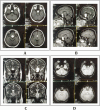A Rare Case of SARS-CoV-2 Infection Associated With Pituitary Apoplexy Without Comorbidities
- PMID: 33501401
- PMCID: PMC7798947
- DOI: 10.1210/jendso/bvaa203
A Rare Case of SARS-CoV-2 Infection Associated With Pituitary Apoplexy Without Comorbidities
Abstract
Pituitary apoplexy is a medical and surgical emergency caused by hemorrhage or infarction of the hypophysis, which typically occurs within a pituitary adenoma. It is usually characterized by severe (often thunderclap) headache, visual disturbances, cranial nerve impairments, and hormonal deficiencies. We herein report a case of a previously healthy woman with severe acute respiratory syndrome coronavirus 2 infection associated with pituitary apoplexy. The plausible pathophysiological mechanisms of pituitary apoplexy in infectious coronavirus disease 2019 are discussed.
Keywords: COVID-19; SARS-CoV-2; pituitary apoplexy.
© The Author(s) 2021. Published by Oxford University Press on behalf of the Endocrine Society.
Figures


Similar articles
-
Pituitary Apoplexy With Pituitary Macroadenoma in a Patient With Asymptomatic COVID-19: A Case Report.Cureus. 2022 Dec 22;14(12):e32810. doi: 10.7759/cureus.32810. eCollection 2022 Dec. Cureus. 2022. PMID: 36694516 Free PMC article.
-
Pituitary Apoplexy as a Complication of COVID-19 Infection.Cureus. 2023 Aug 15;15(8):e43524. doi: 10.7759/cureus.43524. eCollection 2023 Aug. Cureus. 2023. PMID: 37719628 Free PMC article.
-
Pituitary Apoplexy Accompanying Temporal Lobe Seizure as a Complication.World Neurosurg. 2020 Jun;138:153-157. doi: 10.1016/j.wneu.2020.02.148. Epub 2020 Mar 5. World Neurosurg. 2020. PMID: 32147553
-
[Pituitary apoplexy following coronary bypass surgery: A case report and literature review].Rev Med Interne. 2020 Dec;41(12):852-857. doi: 10.1016/j.revmed.2020.07.001. Epub 2020 Aug 13. Rev Med Interne. 2020. PMID: 32800377 Review. French.
-
SARS-CoV-2 Infection, A Risk Factor for Pituitary Apoplexy? A Case Series and Literature Review.Ear Nose Throat J. 2024 Jun;103(1_suppl):153S-161S. doi: 10.1177/01455613231179714. Epub 2023 Jun 8. Ear Nose Throat J. 2024. PMID: 37291861 Free PMC article. Review.
Cited by
-
Pituitary Apoplexy With Pituitary Macroadenoma in a Patient With Asymptomatic COVID-19: A Case Report.Cureus. 2022 Dec 22;14(12):e32810. doi: 10.7759/cureus.32810. eCollection 2022 Dec. Cureus. 2022. PMID: 36694516 Free PMC article.
-
COVID19 infection and vaccination and the risk of pituitary apoplexy: an entangled yarn.Endocrine. 2025 Feb;87(2):459-467. doi: 10.1007/s12020-024-04078-7. Epub 2024 Oct 21. Endocrine. 2025. PMID: 39433700
-
The Multisystem Impact of Long COVID: A Comprehensive Review.Diagnostics (Basel). 2024 Jan 24;14(3):244. doi: 10.3390/diagnostics14030244. Diagnostics (Basel). 2024. PMID: 38337760 Free PMC article. Review.
-
COVID-19 and Endocrine Disorders - Emerging Links in this Puzzle.Indian J Endocrinol Metab. 2021 Jan-Feb;25(1):1-3. doi: 10.4103/2230-8210.322027. Indian J Endocrinol Metab. 2021. PMID: 34386385 Free PMC article. No abstract available.
-
Pituitary Diseases and COVID-19 Outcomes in South Korea: A Nationwide Cohort Study.J Clin Med. 2023 Jul 20;12(14):4799. doi: 10.3390/jcm12144799. J Clin Med. 2023. PMID: 37510914 Free PMC article.
References
-
- Briet C, Salenave S, Bonneville JF, Laws ER, Chanson P. Pituitary apoplexy. Endocr Rev. 2015;36(6):622-645. - PubMed
-
- Tan SK, Seow CJ, Tan E, Chau YP, Dalan R. Pituitary apoplexy secondary to thrombocytopenia due to dengue hemorrhagic fever: a case report and review of the literature. Endocr Pract. 2014;20(4):e58-e64. - PubMed
Publication types
Grants and funding
LinkOut - more resources
Full Text Sources
Other Literature Sources
Miscellaneous
